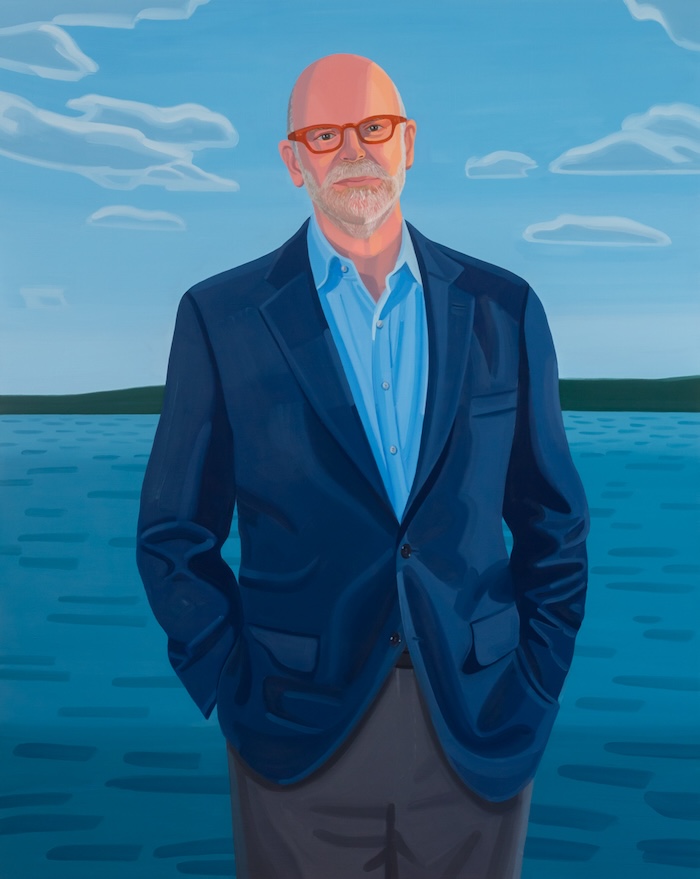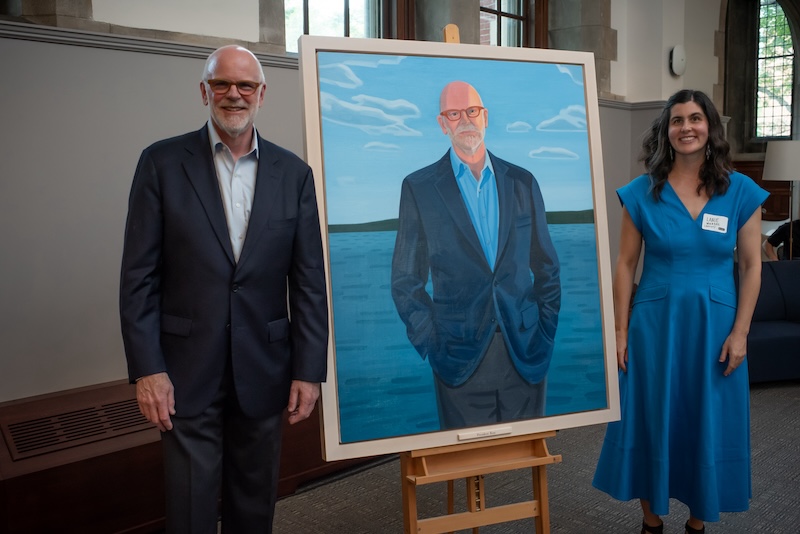Bowdoin’s Presidential Portraiture and the Visualization of Legacy
By Bowdoin College Museum of Art
Helena Wurzel, Portrait of Clayton Rose, 2023, oil on canvas, 50 x 40 in. (127 x 101.6 cm). Bowdoin College Museum of Art, Brunswick, Maine. Commissioned by the President and Trustees of Bowdoin College; Transferred to Museum Collection, 2023.
On September 19, 2024, Bowdoin College unveiled the portrait of its fifteenth president, Clayton Rose, a painting created by Helena "Lanie" Wurzel. Commenting on the work, which deliberately eschews many of the conventions of formal portraiture with its bold use of color and line and its insertion of the figure into the landscape, Wurzel remarked: “Clayton has modeled something that hopefully all of Bowdoin’s students learn during their college years … that while traditions are important, it is possible to give yourself permission to change them and create your own traditions.”
Wurzel’s likeness, which reflects a thoughtful collaboration between subject and artist, prominently features shades of blue, Rose’s favorite color. She positions its sitter in the setting of the Schiller Coast Studies Center on Orr’s Island, which opened during Rose’s tenure. The tonality of the island in the background not only suggests the presence of conifers typical of the region, but even more importantly testifies, as Wurzel puts it, to her subject’s determination to ensure “a greener future for the College.” And indeed, it is notable that during Rose’s tenure three key facilities were established to promote study of the environment and areas affected by the earth’s rapidly changing climate: the Roux Center for the Environment, the Schiller Coastal Studies Center, and the John and Lile Gibbons Center for Arctic Studies. Each building project itself was engineered and built with environmental sustainability in mind.
Although perhaps not deliberate, the portrait’s setting under the skies rather than in an interior space also recalls another—unbidden—part of Rose’s legacy: leading the College through the Covid-19 pandemic. As students returned to campus in the fall of 2020, outdoor classes, meetings, meals, and other gatherings became a central feature of Bowdoin culture.
The first Bowdoin presidential portrait to depict its sitter outdoors, Wurzel’s painting builds on a longer tradition of portraits of Bowdoin presidents that reflect the accomplishments and commitments of the individuals who inspired them. Dating back nearly 200 years, these portraits reflect their subjects’ evolving perspectives on the office and relationship of the institution and the world at large. Reproductions of them are included with biographical sketches of each of Bowdoin’s previous leaders in the Office of the President’s Past Presidents webpage.
The first presidential portrait to be made from life was that of Bowdoin’s third president, William Allen (1820-1839). Attributed to Thomas Badger, the work is believed to have been created when the painter was working in Maine. With imagery that echoes that of Gilbert Stuart’s portraits of American Presidents Thomas Jefferson and James Madison, both of which were on view at Bowdoin College by the time Badger came to campus, the portrait establishes its sitter as an esteemed and learned gentleman, a quality emphasized by the book he holds. An accomplished historian and writer, Allen’s numerous publications included the American Biographical and Historical Dictionary (1809), the first general biography published in the new republic and a supplement to Webster’s Dictionary.
Baxter is also believed to have made a likeness of Bowdoin’s first president, Joseph McKeen, who in his 1802 inaugural address affirmed that education institutions such as Bowdoin “are founded and endowed for the common good,” a core value that the College espouses to this day. One source for the profile of McKeen may have been a silhouette that had been made of him during his lifetime. Thanks to a gift by James Stacey Coles, the ninth president of Bowdoin, that image is now in the collection of the Bowdoin College Museum of Art. (An enlarged reproduction of it now hangs in Massachusetts Hall.) Coles’ sensitivity to the history of the institution over which he presided for fifteen years (1952-1967) is reflected in his own portrait, in which he appears seated in William Searle's Joined Great Chair. Dating back to the seventeenth century, the chair is a celebrated example of early American furniture and is part of the BCMA’s holdings. (One of his successors, A. LeRoy Greason, the College’s twelfth president, also incorporated the chair into his portrait.)
In wearing his academic regalia, Coles followed in the footsteps of his two immediate predecessors, Kenneth Charles Morton Sills (1917-1952) and William DeWitt Hyde (1885 -1917). Hyde, whose “Offer of the College” still reflects some of the College’s foundational aspirations, including “To carry the keys of the world’s library in your pocket; /And feel its resources behind you in whatever tasks you undertake,” undertook a substantial reform of the curriculum and oversaw the construction of several new buildings on campus, including the Walker Art Building, Searles Hall, Sargeant Gym, and Hubbard Hall. To emphasize his academic bone fides through his decision to be portrayed in his doctoral robes, then, was entirely consistent with the legacy he had established for himself at the College. The artist selected for this commission, John White Alexander, was one of the most celebrated portraitists of his generation, reflecting Hyde’s own admonition that all those educated at Bowdoin might “count art an intimate friend.”
Art has indeed featured prominently in recent presidential portraits at Bowdoin. Roger Howell, Bowdoin’s tenth president, engaged Thomas Browne Cornell, a professor of art at the College to create his likeness. Robert H. Edwards, the College’s thirteen president, included in his portrait John G. Brown’s Southwest View of Bowdoin College, Brunswick, Maine, an 1822 painting of the College. Following his prompting, artist Minnette Bickel incorporated other features of Bowdoin iconography, including a polar bear modeled upon the sculpture by Frederic George Richard Roth that stands in front of Smith Union. The painting itself is set in the Office of the President. Yet, undercutting the traditional formality of presidential portraits, Edwards does not sit, but rather leans casually against his desk, as though ready to engage in discussion with the portrait’s viewer.
Edwards’s successor, Barry Mills ‘72, appears in the rotunda of the Art Museum in his portrait, painted by Warren and Lucia Prosperi. Artistic liberty allows a bronze relief of Theophilus Walker by Daniel Chester French to appear at right on the likeness (a lateral reversal of the architectural space) , while a student visible through the rotunda door traversing the quad evokes Mills’s own days as an undergraduate at Bowdoin. Attentive to the importance of the arts to a Bowdoin education, Mills oversaw the renovation of several facilities that feature the arts: the BCMA, Studzinski Hall, the Robert H. and Blythe Bickel Edwards Center for Art and Dance, and Pickard Theater. In a break with tradition, Mills, whose educational credentials include doctorates in biology and law, chose to dispense with academic robes. The College’s fourteenth president appears instead in a suit, indicative, perhaps, of his sensitivity to Bowdoin’s larger engagement with the community beyond campus.
Each presidential portrait, then, reflects important elements of the aspirations and accomplishments of the sitters they feature, as well as providing insights into the College’s own development and relationship to a changing world. Recognizing that these portraits can serve as portals to a rich history, the BCMA is now in the midst of preparing labels that shed new light upon these images, which hang in Hubbard Hall. We look forward to installing them later this fall and hope that current and future generations of the Bowdoin community will enjoy engaging with the numerous leaders who played key roles in shaping the College as we experience it today.
Anne Collins GoodyearCo-Director
